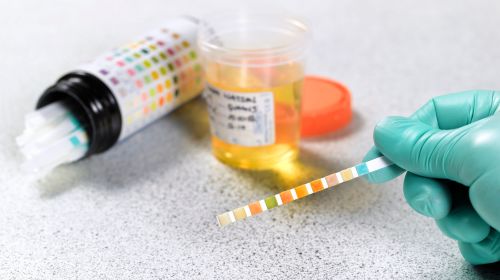Bladder cancer affects men significantly more often than women and occurs primarily in older people. Smoking is considered a major risk factor for the disease. What treatment options are there and how does bladder cancer affect life expectancy?
- © Getty Images/Shidlovski
Quick overview: Bladder carcinoma
Signs: In the early stages, bladder cancer usually causes no or very unspecific symptoms. Blood in the urine is often the first symptom that those affected notice.
Causes: Bladder cancer can have various causes, some of which are preventable. Smoking is considered the main risk factor.
Diagnosis: The most important test for diagnosing bladder cancer is cystoscopy. But urine tests, blood tests, ultrasound and X-ray examinations are also often used.
Treatment: Treatment for bladder cancer depends on the stage and type of tumor. Possible therapeutic strategies include surgery, medication, radiation or immunotherapy.
Article contents at a glance:
What is Bladder Cancer?
Bladder cancer (also known as urinary bladder cancer) is a malignant tumor of the urinary bladder. The organ in which urine collects is located in the lower part of the abdominal cavity. In men, the bladder borders the rectum; in women, it lies directly in front of the uterus. The urinary bladder consists of a muscle layer and a mucous membrane.
Bladder cancer almost always develops in the mucous membrane of the urinary bladder (urothelium). Less commonly, the tissue of other organs of the urinary tract, such as the renal pelvis, can also be affected. Bladder cancer is therefore one of the so-called urothelial carcinomas.
Experts differentiate between two types of bladder cancer:
Non-muscle invasive form: In around 75 percent of cases there is superficial carcinoma, which means that the cancer cells are limited to the mucous membrane.
Muscle invasive bladder cancer: In 25 out of 100 people affected, the cancer cells spread into the muscle layer of the bladder wall and surrounding tissue (aggressive type).
Frequency of bladder cancer
In Germany, around 30,000 people develop bladder cancer every year, 23,000 of whom are men. The mean age of onset is 75 years. Every year more than 5,000 people in Germany die from bladder cancer.
How does bladder cancer manifest itself?
In the early stages, bladder cancer usually has no symptoms. If symptoms occur, they are very non-specific and can also have other causes.
The first symptoms of an advanced bladder tumor are:
Blood in the urine (hematuria): The urine usually appears reddish or brownish. The bleeding is not painful. Blood in the urine can also have other causes, but should always be clarified immediately.
Constant urge to urinate: Those affected often feel like they have to go to the toilet, but can only excrete small amounts of urine.
Women often mistake the initial symptoms of bladder cancer for a bladder infection, and men for prostate problems.
Pain in the abdomen, especially when urinating, only occurs at a later date, if at all. By then the bladder cancer is usually already advanced.
Bladder cancer: Know the causes and risk factors
Bladder cancer is caused by genetic changes in the cells of the urinary bladder, which can lead to uncontrolled growth and tumor formation. There are some risk factors that promote these genetic changes. However, in some cases, bladder cancer can occur without any obvious cause or known risk factors.
Risk factors for bladder cancer:
Smoke: professionals estimate that smoking is responsible for 30 to 70 percent of all bladder cancers. The cancer-causing substances in tobacco enter the blood through the lungs and finally through the kidneys into the urinary bladder. Here the pollutants can develop their harmful effects and promote the formation of tumors. Studies show that bladder cancer is more likely to kill smokers than people who don’t smoke.
Chemicals: Certain chemicals, for example from the group of aromatic amines, are considered another possible cause of bladder cancer. Certain professional groups who are exposed to these substances have an increased risk of bladder cancer. These include, for example, employees in the dyestuffs industry, in the chemical and petrochemical industries and in tar processing companies. According to recent studies, frequent hair coloring has no significant impact on the risk of bladder cancer.
Damaged bladder mucosa: Chronic urinary bladder infections, for example in connection with recurring urinary tract infections or the use of indwelling catheters, represent another risk factor.
Certain medications such as cyclophosphamide, which is used for chemotherapy, or the diabetes drug pioglitazone can also play a role in the development of cancer. Likewise, people who have received radiation therapy to the pelvis are at increased risk of bladder cancer
Parasite can cause bladder cancer
In some Asian, African or South American countries, schistosomiasis is considered the most important risk factor for bladder cancer. Schistosomiasis is an infectious disease whose pathogens live in water. The protozoa (schistosomes) enter the human body via the skin when bathing or drinking infected water via the gastrointestinal tract. In addition to other organs, the pathogens can also infect the urinary bladder and cause damage to the bladder wall. In the worst case, this can lead to cancer.
Bladder cancer: This is how the diagnosis works
To diagnose bladder cancer, a detailed anamnesis is usually carried out first. The exact symptoms and any risk factors are asked. Urologists then carry out a physical examination.
A urinalysis using test strips provides information about the composition of the urine, such as whether there is blood. Looking at the urine under the microscope can also provide clues.
Only cystoscopy allows a closer look at the bladder structure. The procedure is therefore considered the most important test for diagnosing bladder cancer. Doctors insert a narrow tube into the urethra under local or general anesthesia. At the tip of the cystoscope there is a camera connected to a monitor. This makes it possible to take a close look at the wall structure of the bladder. If there are any suspicious changes, tissue samples can be taken directly and later examined in the laboratory.
Further imaging procedures to search for metastases
To confirm the diagnosis and examine whether the tumor has already spread, the following imaging procedures can also be used:
Which blood values are increased in bladder cancer?
Blood tests provide information about whether certain substances, so-called tumor markers, can be detected in elevated concentrations. These are formed in cancer cells, but also in normal cells and are therefore not the sole proof of the presence of bladder carcinoma. However, tumor markers such as CYFRA can provide important information for assessing the success of therapy or the recurrence of cancer.
Bladder cancer treatment
The therapy differs depending on whether the tumor is only superficial (non-muscle invasive) or has already spread into the bladder muscles (muscle invasive bladder carcinoma).
Transurethral resection for non-muscle invasive bladder tumor
Superficially growing bladder tumors are usually treated with a transurethral bladder resection (TUR-B). This is similar to a cystoscopy, but the tumor is removed using an electric loop. To do this, a cystoscope is pushed through the urethra into the interior of the urinary bladder. The tumor tissue can be removed directly under image control. The pieces of tissue are rinsed out and then examined histologically.
The findings provide information about the tumor stage and are crucial for further therapy. The TUR-B is therefore a diagnostic and therapeutic procedure in one. The advantage of this form of treatment is that it works directly at the site of the event, without affecting the entire body. This way, side effects can be avoided.
In order to prevent the recurrence of tumor tissue (recurrence), repeating the TUR four to six weeks after the initial removal of the tumor or tumors on the bladder wall is standard practice. In this way, any remaining tumors can be removed. In addition, experts usually recommend so-called intravesical instillation therapy following TUR-B. Medication is introduced into the bladder via a catheter, causing the destruction of any tumor cells that may be present.
Therapy for muscle-invasive bladder cancer
Various procedures are available to treat the aggressive and deeper (invasive) variant of bladder cancer. Complete removal of the bladder (radical cystectomy) has the best chance of recovery. Patients then receive an artificial urinary diversion, such as a stoma or a neobladder.
Chemotherapy or radiation therapy before and after surgery is an additional treatment option. Before surgery, these procedures can help shrink the tumor. But their use can also be useful after the operation to improve the chances of success.
The guideline has also recently recommended so-called immunotherapy, which has a more specific effect than chemotherapy or radiation therapy, for advanced or metastatic bladder cancer. Checkpoint inhibitors are used for this. These are artificial antibodies that enable the T cells of the immune system to recognize, attack and eliminate cancer cells.
Prognosis and course of bladder cancer
Three out of four bladder carcinomas are superficial and have a good prognosis. The 5-year survival rate is over 80 percent. However, despite successful treatment, a recurrence can occur in many cases.
Tumors that have invaded deeper layers of the bladder wall usually require more extensive treatment. They have an increased tendency to form secondary tumors (metastases) in lymph nodes and more distant organs such as the liver and lungs. If metastases have formed, five to ten percent of patients are still alive after two years.
How can bladder cancer be prevented?
The most important measure to prevent bladder cancer is to stop smoking or not to start smoking at all.
Anyone who works in the dyestuffs industry, the chemical industry or in tar processing companies should definitely adhere to the relevant occupational health and safety regulations in order to protect themselves from harmful chemicals.
Some studies also suggest that carcinogenic substances are more dangerous the longer and more concentrated they come into contact with the bladder wall. That’s why adequate fluid intake is important. At least 1.5 liters per day is recommended.



